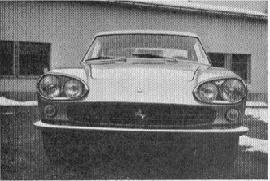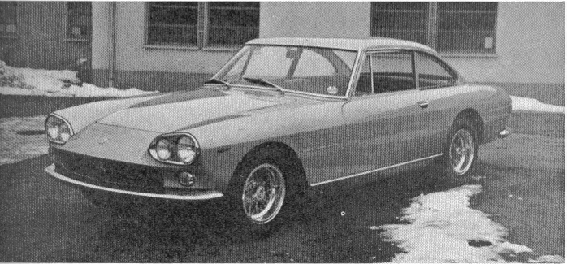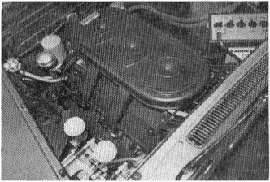 | 330 GT Registry |  |
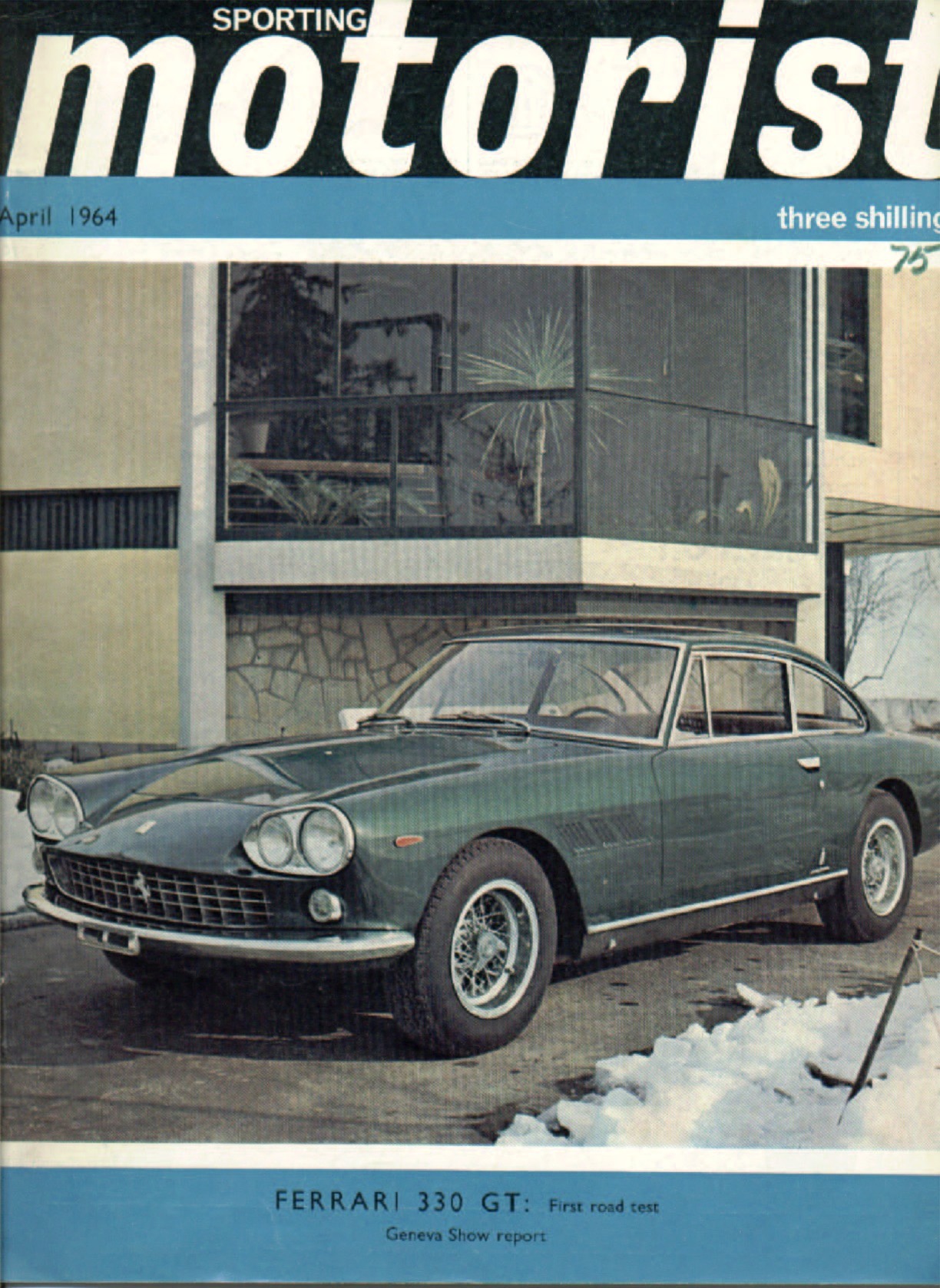

FROM OUR CORRESPONDENT IN ITALY ETIENNE CORNIL |
| Twin headlamps sunk in ovoid nacelles surmount a clean Pininfarina grille |
|
It would be foolish to pass a final opinion on the future of the new Ferrari 330 GT in the world of high performance cars on the strength of a mere 200 km test. But in the course of a high-speed run on the Autostrada del Sole and on the hairpins which bring you up to the heights of the Abetone, the 330 GT showed an astonishing potential and a wealth of unexpected talents.
Like all the thoroughbreds sired in the Pininfarina stables, the “performance” starts when one gets into the car. The interior is given a most individual treatment, greater attention having been given to functional design than pure luxury. The front seats are extremely comfortable, without being too soft; it is not just in sharp cornering that one appreciates the well designed contours of the seats, which seem to have been made to measure. For the back seat passengers, the bench seat with central armrest is of course less generous, but two adults have sufficient room without having their legs cramped, even when the front seats are adjusted right back. The headroom is equally satisfactory, though limited by the thick padding of the roof lining. In spite of an overall height of 3 ft 10 in, the Ferrari 330 GT can be considered as a genuine 4-seater.
The driver, however, occupies the most important seat in the car: in front of him stretches an imposing black dash board covered in thick foam rubber padding. The many dials, eight in all, are also on a black background and are only eye-catching for their purpose in life. In comparison with the Coupé 2 + 2, the gear lever comes nearer to hand (owing to the longer gearbox) whereas the steering wheel, which is smaller, has been lowered by 2 in, thereby offering better grip and better vision.
It goes without saying that these improvements, which appear to have secondary importance, come into their own when 300 horses of purest latin strain are unleashed by this 4-litre V12 engine.
Contrary to what we have come to expect of a Ferrari, with the 330 GT the dominant feature is no longer the tormented snarl of its engine. Remarkably enough, the new-comer appears in a much more civilised garb. When taking the road, our attention was immediately drawn to the exceptional level of silence; this can be attributed to the adoption of an air filter not yet in common use, and to the novel methods of sound insulation. Nevertheless the result remains surprising, when one thinks of the uproar caused by three massive twin choke carburettors, the roar of four exhausts, and the operation of 24 valves by a veritable regiment of rockers. In keeping with its pedigree, the Ferrari 330 GT has very fine aerodynamic properties and it is only over 125 mph that wind noise prevents normal conversation. At these speeds the car which we tested produced a very high pitched whistle which was probably caused by the wiper arms being directly in the path of the airflow over the windscreen.
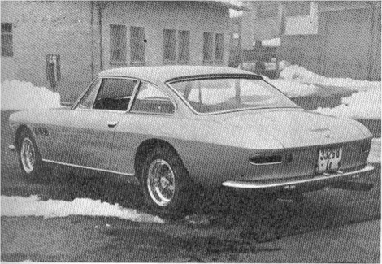 | Ferrari’s new contender for the title of the world’s fastest four-seater |
| Shapely tails can also look purposeful, especially if four large-diameter tailpipes protrude beneath. Nevertheless, this Ferrari is more silent than any previous example of the breed | |
| |
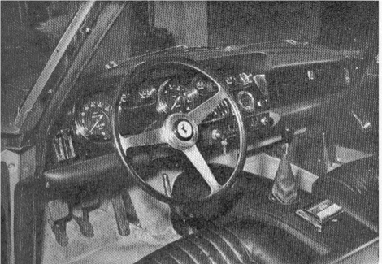 | Before its proving run the 330GT is posed among seasonal traces of snow. Note the exceptional rim width of the light-alloy Borrani wire wheels |
| Instrumentation has always been a strong point of Pinin farina bodied Ferraris. A restful black background is provided for a formidable array of dials, which, in their turn are white lettered on black. Switches of piano key type are grouped centrally, while the short gear lever is immediately to hand. Heater controls are on the left. | |
0-100 mph in 15.4 seconds
A huge aircleaner, which hushes the hoarse throats of the triple twin-choke Webers, emphasises the compactness of the Vl2 power unit | |
| |
These are the Pirelli Cinturato 205 x 15 tyres which must take credit for the remarkably good road adhesion of the car. | 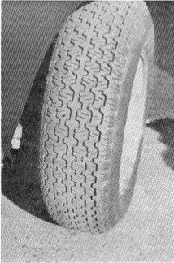 |
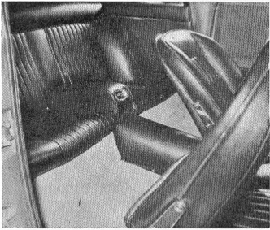 | |
Lushly upholstered rear seats are reached via a folding front-seat backrest | |
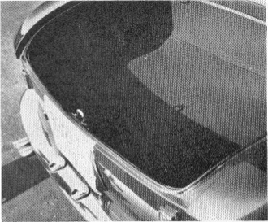 | |
Luggage carrying capacity has rarely been a strong point of Ferraris, but the 330GT has a wide flat-floored boot quite capable of holding a sensible amount of baggage | |
Detail furnishing and design is of a high standard, as witnessed the trim on the inside of the door. A long armrest develops into a substantial door pull, shielding the window winder, | |
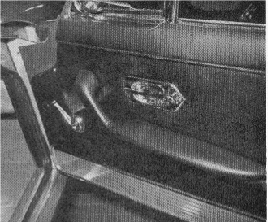 | |
In spite of a more sedate appearance, the Ferrari 330 GT remains a car whose appeal hinges on its high performance. On taking the engine to its limits, acceleration through the gears is really vivid and uses to the full that exclusive (for the present) property of the Ferrari engine which provides a firing stroke for every 60 degrees of crankshaft rotation together with moving parts that have, on top of their very reduced inertia, an inherent dynamic balance. Around 5,000 rpm when the engine reaches its maximum torque output, the sound level is more in evidence without, however, exceeding the noise that everyone expects of a 12-cylinder Ferrari.
In the intermediate gears it is possible to extend the engine to 7,000 rpm for a short time, but for normal use the makers recommend a limit of 6,600 rpm and at these revs the car reaches respectively 50, 74, 100 and 125 mph in the four ratios.
Using the fantastic power up to 7,000 revs in the first two gears, we achieved 0-63 mph in 7.2 secs, even though with two people and approximately 65 litres of petrol the effective power to weight ratio was brought down nearly to 200 bhp per ton net. In these conditions 100 mph was reached in 15.4 secs, while the standing kilometre took 26.6 secs at which point the car had reached 125 mph. At this speed the Laycock de Normanville overdrive was brought in by means of a small switch under the steering wheel. This, unlike on the Coupé 2+2, automatically cuts out on changing gear.
Due to traffic conditions, it was not possible to cover one complete kilometre in excess of 6,000 rpm in over drive. This engine speed corresponds exactly to 141 mph, and another 400 rpm should have produced the 153 mph advertised as the maximum speed by the factory. In addition to the acceleration, which places it amongst the fastest GT cars on the market, the Ferrari 330 GT also boasts tractability comparable to the best achieved on the other side of the Atlantic. For those who like to potter along at 1,000 rpm in overdrive, the Ferrari 330 GT shows unexpected docility, and without the least hesitation accelerates smoothly away in this gear, which is most un-Ferrari-like behaviour by any standards. Better still for a driver determined not to use the gearbox, it is possible to start off in fourth overdrive without any difficulty. In order to do this it is necessary to slip the clutch (which is as easy to do as on any family car) between 600 and 1,000 rpm, after which you can put your foot flat on the boards without further worry. Moreover, in spite of the high back axle ratio (4.25:1), the car takes only 13.2” to reach 100 mph from 50 mph in direct drive, and the same test requires but an extra 5.8” when the overdrive is switched in. If the exceptional performance of the Ferrari 330 GT can be directly attributed to the sophisticated design of the engine and the faultless gear box, it stems also from an overall concept of first class design. Thus there is no doubt that the inherent road holding qualities of the car have benefited by the fitting of the new Pirelli 205 x 15 in tyres. While retaining its radial ply construction made famous by the name of Cinturato, this tyre is now made of more pliable cling rubber which, combined with a wider tread, does not detract from its cornering ability and improves its grip when breaking and accelerating.
During cornering, the power reserve allows you to balance the car nicely and to correct its slight tendency to understeer. Coming out of corners the combined action of the ZF limited-slip differential and the ample contact area of the tyres allows you to accelerate much earlier and with more gusto, and this without affecting the chosen line through the bend. Because of this, the 330 GT is blessed with exceptional speed on twisty roads and on coming out of corners it leaps forward like a rocket, leaving behind two thick black tyre marks.
It is worth mentioning on the other hand that the large dimensions of the tyres do not convey any uneasy feeling through the steering (of worm and roller type) and although the necessity for a vibration damper leaves something to be desired, at low speeds the frictional resistance is largely compensated for by the extreme softness of steering.
The Ferrari 330 GT also deserves a good word for immaculate behaviour during braking: its design has be the subject of intensive study, and the Baldwin booster which operates on the front brakes of the Coupé 2 + 2 h this time been abandoned in favour of twin hydraulic circuits with individual servo. Braking effort is accomplished by bigger twin master cylinders. Out of curiosity we took the car from 0 to 100 mph and back to rest; the test was accomplished with extreme ease and in exceptional time of 22.5” It would be hazardous to measure maximum braking ability solely on the basis of stopping time, but it appears likely that at the end of the braking period instantaneous deceleration would be higher than the average, that is beyond 485 ft per sec.
In offering a genuine four seater with this high performance, the new Ferrari 330 GT will without doubt enjoy a degree of success that will be likely to extend the production capacity of the new and larger Ferrari motor works Maranello to its limit
.
SPECIFICATION AND PERFORMANCE
ENGINE:
V12 cylinders; bore 77 mm (3.05 in), stroke 71 mm (2.8 in). Cubic capacity 3,967 cc. Compression ratio 8.8:1. Maximum bhp (net) 300 at 6,600 rpm. Maximum torque 246 lb ft at 5,000 rpm. Marchal 34 HF
sparking plugs; 3 twin-choke Weber type 40 DFI carburettors; single overhead camshafts to each bank; inclined overhead valves with rockers; mechanical fuel pump with self-regulating auxiliary electric pump, manually controlled. Tank capacity 19.8 Imp gallons. Cooling by water radiator with Peugeot thermo-magnetic fan, capacity 3½ gallons. Sump capacity 2½ gallons. 12v battery of 60 amp/hr capacity with alternator.
TRANSMISSION:
Clutch: single dry plate. Four speed all-synchromesh gearbox with self-cancelling overdrive on 4th. Gear ratios: 1st, 2.536:1. 2nd 1.700:1. 3rd, 1.256:1. 4th, 1:1. 4th o’drive,0.778:l. Reverse, 3.218 Final drive, 4.25:1. Axle: Rigid with fore and aft location rods.
CHASSIS:
Suspension: front, independent with wishbones, helical spring roll bar and Koni telescopic shock absorbers; rear, semi-elliptic springs with Koni shock absorbers supplemented by helical springs. Dunlop disc brakes operated by a tandem master cylinder with separate hydraulic circuits and servos. Handbrake on rear wheels. Worm and roller steering. Borrani wire wheels with light all rims; tyre size 205 x 15.
| DIMENSIONS: | |||
| ft 8 4 4 16 5 3 44 27 | in 8.2 7 6.5 1.5 6.5 10.0 4.75 0 cwt | |
| PERFORMANCE: | |||
mph | sec 2.9 4.1 5.6 7.1 9.7 11.2 13.0 15.4 19.8 24.5 | ||
Maximum speed in gears: | 50 mph 74 mph 100 mph 125 mph 153 mph | ||
| Fuel consumption: PRICE: £6,217 | 14-16 mpg | ||
April, 1964 Sporting Motorist
